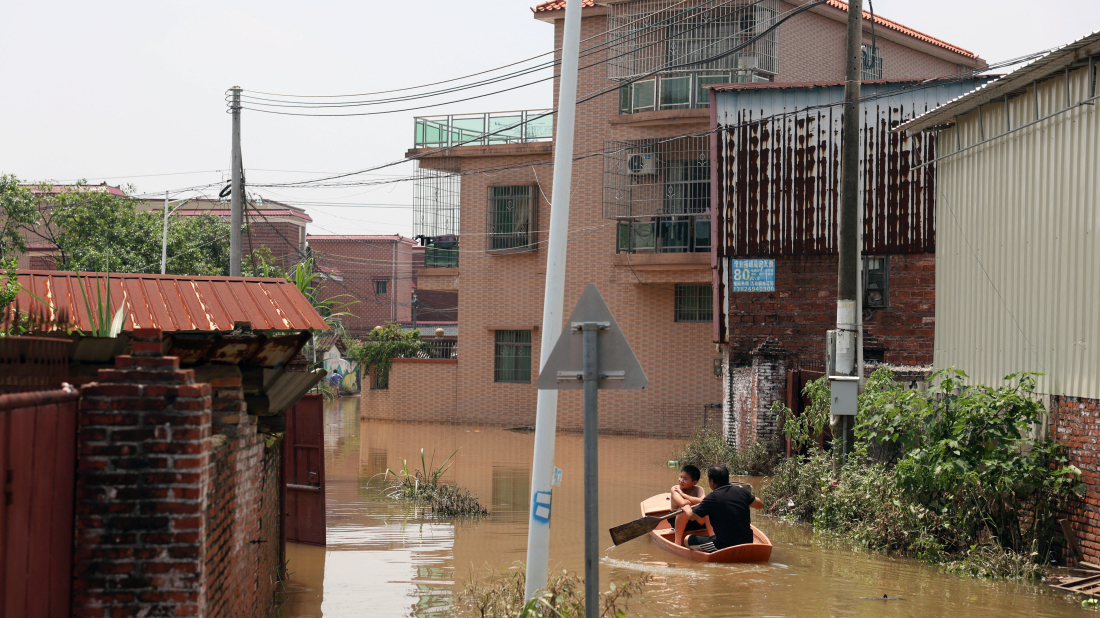Trump sues BBC for defamation over edited January 6 speech, demands $10 billion in damages
President Donald Trump has filed a defamation lawsuit against the BBC over edited footage of a speech that made it appear he encouraged supporters to ...

The residents of Pingtou, a small village in China's southern Guangdong province, are grappling with the worst floods in living memory. While the region is accustomed to typhoons and seasonal downpours, this week’s flooding has shocked even the oldest villagers.
Between August 2 and 6, a record 622.6 mm (24.5 inches) of rain fell on Guangzhou, the provincial capital—nearly three times the city’s average August rainfall. According to state media, at least seven people died in Guangzhou, while no fatalities have been confirmed in Pingtou so far.
In Pingtou, the flooding has left homes submerged and streets waterlogged. Villagers waded through brown, knee-deep water on Friday, dragging damaged belongings from their homes. At least four buildings collapsed during the torrential rains.
“The older folks say that in the 100 years we've been here, they've never seen flooding like this,” said Mr. Zhong, a resident in his 50s. Water marks on nearby homes rose more than a metre high.
Lack of warning and support
Despite the scale of the flooding, residents say they received no warning or alerts. Many were caught off guard during the night.
73-year-old Zhang was woken by her daughter-in-law and took shelter in her son’s two-storey home. The next morning, she discovered her own house had collapsed.
“I’d been living in that house for over 50 years,” she said, sifting through the wreckage.
Others echoed frustration over the absence of government support. Mr. Zhong said officials told residents there was no relief aid available.
“There wasn’t even a bottle of mineral water provided,” he said.
Economic loss for farmers
Outside the village, local fish and duck farmer Hu Songlin said the floods had swept away his fish stock, causing immediate losses estimated at 120,000 yuan.
“Now we won’t be able to earn a single cent,” his wife Hua said.
Wider climate impact across China
The crisis in Pingtou is part of a larger pattern of extreme weather affecting China. The country is currently dealing with record rainfall in both its northern and southern regions, alongside extended heatwaves in its interior provinces.
On Thursday, China’s central government announced 430 million yuan ($59.9 million) in additional disaster relief funding, raising the total since April to over 5.8 billion yuan. Yet, many local communities, such as Pingtou, report not seeing this support on the ground.
Climate change a driving factor
Experts point to climate change as a key driver of the country’s increasing weather volatility.
“Global warming can lead to more intense rainfall,” said Professor Johnny Chan of the City University of Hong Kong. “But there’s only so much water—so when one region gets more, others get less. We're seeing wetter areas get wetter, and dry regions become even drier.”
Russia’s human rights commissioner, Tatyana Moskalkova, has said that Ukraine has not provided Moscow with a list of thousands of children it alleges were taken illegally to Russia, despite the issue being discussed during talks in Istanbul.
An explosive device found in a vehicle linked to one of the alleged attackers in Bondi shooting has been secured and removed according to Police. The incident left 12 people dead.
Syrian President Ahmad al-Sharaa has offered condolences to President Donald Trump following an ISIS attack near the ancient city of Palmyra that killed two U.S. soldiers and a civilian interpreter, Syrian and U.S. officials said Sunday.
At least 17 people, including students, were killed and 20 others injured after a school bus fell off a cliff in northern Colombia on Sunday, authorities said.
At least 14 people have died and 32 others were injured after flash floods swept through Morocco’s Atlantic coastal city of Safi on Sunday, authorities said.
At least 37 people have been killed in flash floods triggered by torrential rain in Morocco's Atlantic coastal province of Safi, Moroccan authorities said on Monday (15 December).
Climatologists say Poland has logged its warmest December in 74 years, with 2025 continuing a run of above-average temperatures and repeated national records.
As the world marks the tenth anniversary of the Paris Agreement, progress in combating global climate change is mixed.
An extratropical cyclone has caused widespread disruption across Brazil’s São Paulo state, with powerful winds toppling trees and power lines, blocking streets and leaving large parts of the region without electricity.
Indonesia's military stepped up its relief efforts in three provinces on Sumatra island that have been devastated by deadly floods and landslides, and the country's vice president apologised for shortcomings in the response to last week's disaster.
You can download the AnewZ application from Play Store and the App Store.

What is your opinion on this topic?
Leave the first comment